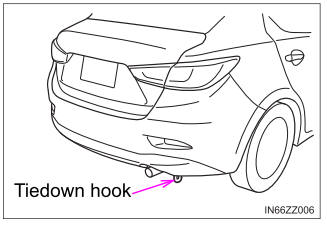Toyota Yaris: Tiedown Hooks (If equipped) / Tiedown Hook-Rear
Toyota Yaris XP210 (2020-2025) Owner's Manual / If Trouble Arises / Emergency Towing / Tiedown Hooks (If equipped) / Tiedown Hook-Rear
The hook positioned under the rear bumper on the right side is for tying down the vehicle during transport, and it cannot be used for towing other vehicles.
It can be used as a towing hook only when the vehicle must be towed by another vehicle in an emergency case such as when the vehicle is stuck in snow, however, it may damage the bumper.

NOTICE
When using the hook in such emergency cases, observe the following so as not to damage the tiedown hook or the vehicle body.
- The vehicle must be pulled straight to the rear so that no load is applied to the vehicle in the lateral direction.
- The bumper may be damaged if the tie down hook is used as a towing hook.
- When using a metal chain or wire cable, wrap a cloth around the attachment area. If the metal chain or wire cable contacts the bumper directly, the bumper could be scratched or damaged.
 Tiedown Hook-Front
Tiedown Hook-Front
Remove the tiedown eyelet and the lug wrench from the luggage
compartment.
Wrap a jack lever or similar tool
with a soft cloth to prevent damage to a painted bumper, and
open the cap located on the
front bumper...
Other information:
Toyota Yaris XP210 (2020-2025) Reapir and Service Manual: Freeze Frame Data
FREEZE FRAME DATA DESCRIPTION (a) When a front camera system DTC is stored, the forward recognition camera stores the current vehicle (ECU or sensor) state as Freeze Frame Data. CHECK FREEZE FRAME DATA (a) Select a DTC to display the freeze frame data...
Toyota Yaris XP210 (2020-2025) Reapir and Service Manual: System Diagram
S..
Categories
- Manuals Home
- Toyota Yaris Owners Manual
- Toyota Yaris Service Manual
- Fuse Panel Description
- Opening and Closing the Liftgate/Trunk Lid
- Adjustment
- New on site
- Most important about car
Break-In Period
No special break-in is necessary, but a few precautions in the first 600 miles (1,000 km) may add to the performance, economy, and life of the vehicle.
Do not race the engine. Do not maintain one constant speed, either slow or fast, for a long period of time. Do not drive constantly at full-throttle or high engine rpm for extended periods of time. Avoid unnecessary hard stops. Avoid full-throttle starts.
Copyright © 2025 www.toyaris4.com

